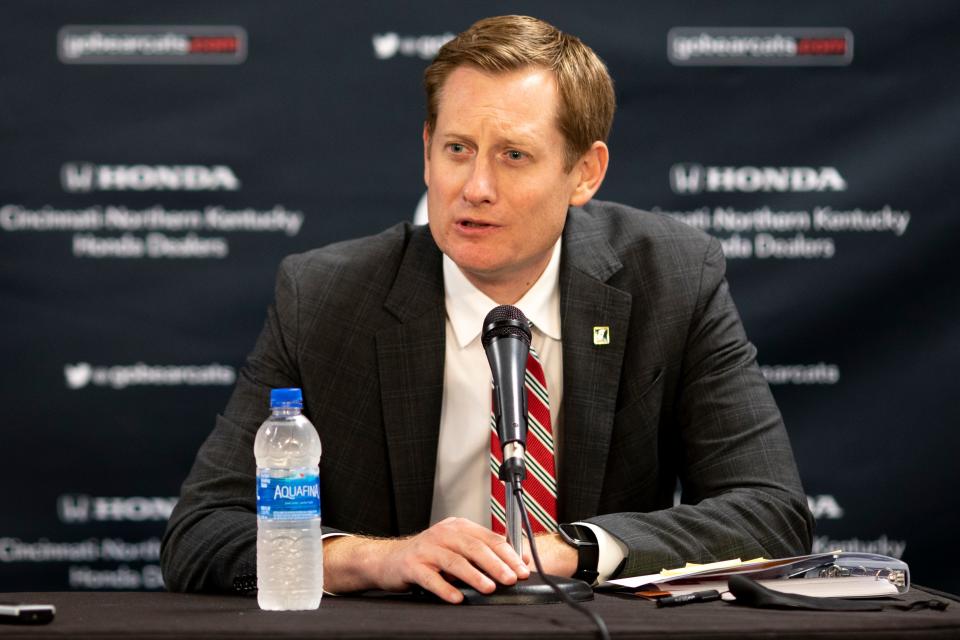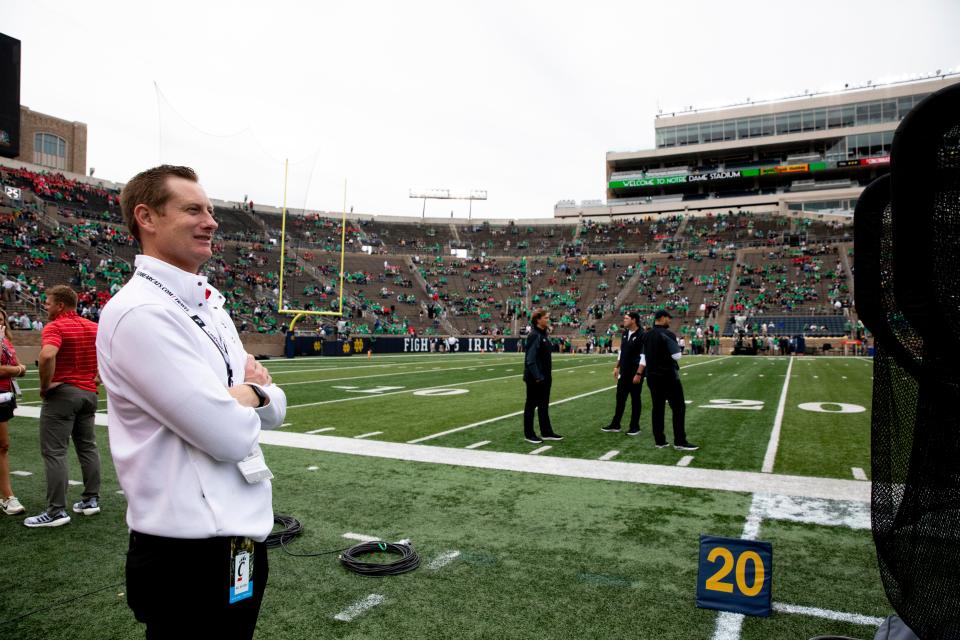Tramel: Cincinnati athletics bet on itself and now is joining the Big 12
CINCINNATI — On the east edge of the University of Cincinnati campus sits a plot of ground that represents why the Bearcats were invited into the Big 12.
On May 23, UC dignitaries donned hard hats and grabbed shovels for the ceremonial groundbreaking of the school’s new indoor practice facility and performance center. Price tag: between $100 million and $134 million. The new facility will replace an indoor bubble built in 2012.
Next to the vacant lot sits UC’s Fifth Third Arena, home of the Bearcats’ storied basketball program. Built in 1989 as the Shoemaker Center, the arena underwent an $87 million renovation in 2018-19 and in March began further improvements.
Add in the 2014-15 expansion and upgrade at Nippert Stadium, and just three projects cost the Bearcats around $300 million.
Football success put the University of Cincinnati on Big 12 radars. But a commitment to athletic success got the Bearcats through the door.

UC joins the Big 12 on July 1, and the Bearcats deserve this chance. Without the financial windfalls of Power Five Conference television money, Cincinnati bet on itself and found a seat at the table.
“We've been outperforming resources, knocking at the door,” said UC athletic director John Cunningham, who was hired in December 2019. “Tremendous vision by our president (Neville Pinto) and board. We were doing that whether we got an invite to the Big 12 or not. We needed it.”
Don’t misunderstand. Cincinnati is not entering the Big 12 locked and loaded to run astride the conference’s best programs in facilities and budgets. No school outside the power structure is fully prepared for transition to the highest levels of college athletics.
UC will get a half share of Big 12 revenues the first two years. Its budgets will grow gradually in trying to catch the Baylors and Oklahoma States and Kansases. Some of Cincinnati’s Olympic sports initially will be below par in Big 12 competitiveness.
That’s the norm. Heck, Texas Christian baseball is the perfect example. The Horned Frogs had made nine straight NCAA Tournaments when they joined the Big 12 in 2012, and since then they’ve made the College World Series five times. But TCU’s first Big 12 team, 2013, went 29-28 and didn’t qualify for the postseason.
But Cincinnati is not waiting to gets its recruiting budgets up to Big 12 norms. Or in the ways it treats its athletes.
“You learn very quickly where you match up well with the Power Five and where you need to build,” Cunningham said. “We immediately identified we have to build nutrition. We have been feeding our student-athletes, but we haven’t been fueling them. And there's science behind that.”
The new performance center includes a nutrition element, and Cunningham has beefed up UC’s nutrition staff. But that’s the kind of thing Cincinnati financially was strapped to do in the past.
More: Tramel: University of Cincinnati & Nippert Stadium bring unique urban feel to Big 12

“Things we've been piece-mealing together, now we're jumping all in,” Cunningham said.
It’s not just conference money that makes the difference. The Big 12 affiliation has lit a fuse in Cincinnati.
Brad Okel, executive director of UCats, the athletic department’s fundraising wing, said athletic donors have increased from 5,800 to 8,000 in the 21 months since the Big 12 invitation arrived.
Okel said he worried that the initial wave of donations might be a flash, but UC athletics raised a healthy $39 million this fiscal year.
“I think it's as much attitude as nuts and bolts, to be Big 12 ready,” said John Daniel, the department’s chief financial officer. “So many times UC has been restricted by its own finances … we’re not looking to take any more shortcuts, put any band-aids on it.
“The good news is, the major investments, with the arena and the stadium projects, were a perfect segue into that performance center.”
Cincinnati has a parachute in men’s basketball. The Bearcats have a proud history. Only eight schools have more than UC’s two NCAA championships. The Bearcats are tied for 10th all-time with six Final Fours. They are 18th all-time in NCAA Tournament wins, with 46. That will rank second in the Big 12, behind only Kansas.
UC has struggled since Mick Cronin resigned in 2019 to take the UCLA job. John Brannen was fired after two seasons, in part for alleged mistreatment of players, but Wes Miller’s second Bearcats team went 23-11 overall, 11-7 in the American Conference last season, and hopes are high that Cincinnati is on the rebound.
Miller says the Big 12 will do wonders for his program.
“I'm really excited about it,” Miller said. “If you look at the recent history, it’s unquestionably the best basketball league in the country.
“It’s certainly impacted our recruiting a great deal. Cincinnati is a national brand, and this program has been on the national map of college basketball for decades. We've always been able to get involved with the best recruits and best players in the country. But sometimes it was difficult because they wanted to play in the best leagues.”
More: Tramel: Cincinnati football enters Big 12 without Luke Fickell or the momentum he built
Other Cincinnati sports could take longer to adjust.
Volleyball has been quite competitive and could do well in the Big 12.
Baseball has a cool stadium – originally named for the late Marge Schott, controversial owner of the Cincinnati Reds – but needs some facility upgrades, Cunningham said.
UC women’s basketball hasn’t made the NCAA Tournament in 20 years. Golf could struggle, just on weather alone, since the Big 12 is a golfing powerhouse. Most other Cincinnati Olympic sports didn’t distinguish themselves in their 10-year American Conference history.
“It takes three, four years to get up to speed” financially, said football coach Scott Satterfield. “Get the full share of dollars. It all filters down in how you do everything. How you travel. How you take care of student-athletes. There's levels to all that.”
But the jump to the Big 12 also pays off immediately in other ways. Staff recruiting and retention, for example. Name, image and likeness deals for athletes, especially in a vibrant city like Cincinnati.
And the things UC could do, it has done. Including the big boulders of major facilities.
“That's what we always talk about,” Cunningham said. “Systemic investment with the eye on some day, if and when the opportunity arose, we were going to be ready.
“That’s why September 12, 2021, was so important. We had donors that were in tears, because the investment, the time and effort, were kind of coming to heat there. We've got tremendous support, a huge alumni base, and this will just give them even more fuel to their fire to make sure this program continues to compete.”
Cincinnati spent big with no guarantee of a major-conference berth. But that investment paid off, and in two weeks, UC will be in the Big 12.
Berry Tramel: Berry can be reached at 405-760-8080 or at btramel@oklahoman.com. He can be heard Monday through Friday from 4:40-5:20 p.m. on The Sports Animal radio network, including FM-98.1. Support his work and that of other Oklahoman journalists by purchasing a digital subscription today.
Big 12 newcomers
On July 1, Cincinnati, Brigham Young, Central Florida and Houston join the Big 12 Conference. The Oklahoman’s Berry Tramel has ventured to all four campuses for a series of columns on the Big 12 newcomers. His BYU series ran last summer, but we count down towards July 1 with three-part series on each of the other three, bookended by BYU columns. The schedule:
Monday: BYU president Shane Reese
Tuesday-Thursday: Cincinnati
June 20-22: Houston
June 27-29: Central Florida
July 2: BYU’s celebration
This article originally appeared on Oklahoman: Cincinnati Bearcats' investment in facilities pays off with Big 12 bid

